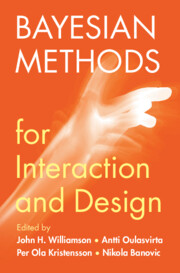Refine search
Actions for selected content:
48416 results in Computer Science

Bayesian Methods for Interaction and Design
-
- Published online:
- 18 August 2022
- Print publication:
- 25 August 2022
Part III - Generative Models
-
- Book:
- The Science of Deep Learning
- Published online:
- 23 September 2022
- Print publication:
- 18 August 2022, pp 151-152
-
- Chapter
- Export citation
Matrix Calculus
-
- Book:
- The Science of Deep Learning
- Published online:
- 23 September 2022
- Print publication:
- 18 August 2022, pp 293-295
-
- Chapter
- Export citation
Preface
-
- Book:
- The Science of Deep Learning
- Published online:
- 23 September 2022
- Print publication:
- 18 August 2022, pp xv-xvi
-
- Chapter
- Export citation
Part IV - Reinforcement Learning
-
- Book:
- The Science of Deep Learning
- Published online:
- 23 September 2022
- Print publication:
- 18 August 2022, pp 191-192
-
- Chapter
- Export citation
3 - Optimization
- from Part I - Foundations
-
- Book:
- The Science of Deep Learning
- Published online:
- 23 September 2022
- Print publication:
- 18 August 2022, pp 35-55
-
- Chapter
- Export citation
Contents
-
- Book:
- The Science of Deep Learning
- Published online:
- 23 September 2022
- Print publication:
- 18 August 2022, pp v-xiv
-
- Chapter
- Export citation
12 - Deep Reinforcement Learning
- from Part IV - Reinforcement Learning
-
- Book:
- The Science of Deep Learning
- Published online:
- 23 September 2022
- Print publication:
- 18 August 2022, pp 229-250
-
- Chapter
- Export citation
1 - Introduction
- from Part I - Foundations
-
- Book:
- The Science of Deep Learning
- Published online:
- 23 September 2022
- Print publication:
- 18 August 2022, pp 3-8
-
- Chapter
- Export citation
Part I - Foundations
-
- Book:
- The Science of Deep Learning
- Published online:
- 23 September 2022
- Print publication:
- 18 August 2022, pp 1-2
-
- Chapter
- Export citation
7 - Graph Neural Networks
- from Part II - Architectures
-
- Book:
- The Science of Deep Learning
- Published online:
- 23 September 2022
- Print publication:
- 18 August 2022, pp 124-141
-
- Chapter
- Export citation
5 - Convolutional Neural Networks
- from Part II - Architectures
-
- Book:
- The Science of Deep Learning
- Published online:
- 23 September 2022
- Print publication:
- 18 August 2022, pp 69-90
-
- Chapter
- Export citation
9 - Generative Adversarial Networks
- from Part III - Generative Models
-
- Book:
- The Science of Deep Learning
- Published online:
- 23 September 2022
- Print publication:
- 18 August 2022, pp 153-173
-
- Chapter
- Export citation
References
-
- Book:
- The Science of Deep Learning
- Published online:
- 23 September 2022
- Print publication:
- 18 August 2022, pp 299-334
-
- Chapter
- Export citation
Part II - Architectures
-
- Book:
- The Science of Deep Learning
- Published online:
- 23 September 2022
- Print publication:
- 18 August 2022, pp 67-68
-
- Chapter
- Export citation
Part V - Applications
-
- Book:
- The Science of Deep Learning
- Published online:
- 23 September 2022
- Print publication:
- 18 August 2022, pp 251-252
-
- Chapter
- Export citation
6 - Sequence Models
- from Part II - Architectures
-
- Book:
- The Science of Deep Learning
- Published online:
- 23 September 2022
- Print publication:
- 18 August 2022, pp 91-123
-
- Chapter
- Export citation
10 - Variational Autoencoders
- from Part III - Generative Models
-
- Book:
- The Science of Deep Learning
- Published online:
- 23 September 2022
- Print publication:
- 18 August 2022, pp 174-190
-
- Chapter
- Export citation
Abbreviations and Notation
-
- Book:
- The Science of Deep Learning
- Published online:
- 23 September 2022
- Print publication:
- 18 August 2022, pp xix-xxii
-
- Chapter
- Export citation
Acknowledgments
-
- Book:
- The Science of Deep Learning
- Published online:
- 23 September 2022
- Print publication:
- 18 August 2022, pp xvii-xviii
-
- Chapter
- Export citation
